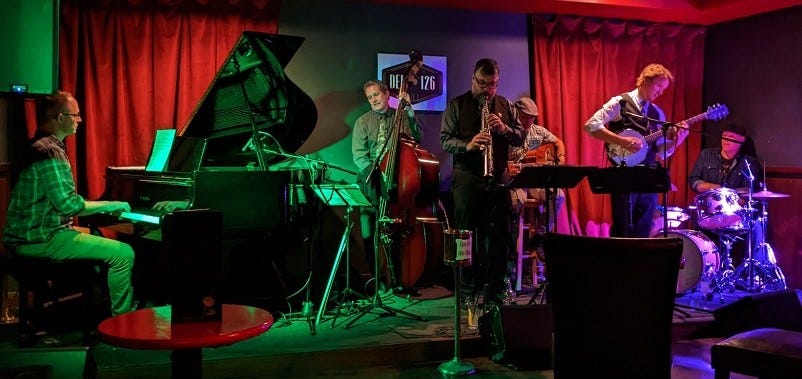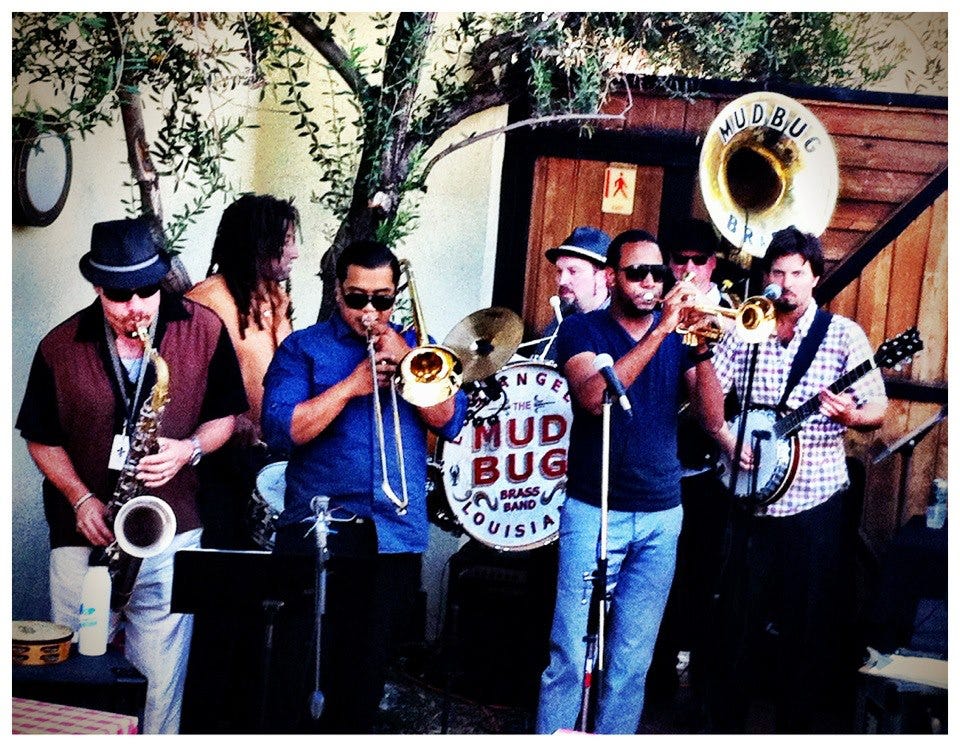Holding Down A Weekly Gig
"If you lose the spirit of repetition, your practice will become quite difficult" - Shunryu Suzuki

On a Wednesday night in the spring of 1988, I saw The Fringe at The Willow Jazz Club in Somerville, MA. I must have been with my friend Ethan, who was a couple of years older than me and had his driver’s license. We both played saxophone in our high school jazz band. He told me about tenor player George Garzone and his legendary trio that held down a weekly gig in Boston since the mid-70s. He’d heard about them from his older brother.
The Willow was not an inviting space for music or anything else. The room was rectangular, with the narrow end facing the street. The stage was halfway down the right-hand wall as you walked in. It was so narrow that if you sat in front of the band, you’d spend the night with an instrument or two in your face, frequently contorting to allow the lone server, usually Diane, to get by with a couple of bottles of Bud in her hand. The disco ball overhead hinted at a past with dancers, but now a baby grand piano sat beneath it. At the top of the wall behind the band, there was a red material border, dirty and adorned with neglected LP covers, slowly falling off as the years passed. It reeked of stale beer and cigarettes. But the room hosted Boston’s hottest post-bop and avante-garde jazz players seven nights a week, and the complete lack of pretense that anything about the place was fancy or even nice meant that the musicians and the audience were “all about the music.” While the club had its own set of regular and unusual characters, the sight of the bar next door on a trip to the bathroom evoked dark corners of a Bukowski or William S. Burroughs novel—midweek anyway. On weekends, it would get raucous. There were boisterous Bruins fans and loud before-the-days-of-karaoke sing-alongs to Frank Sinatra’s “My Way.” It's not difficult to imagine for anyone who’s spent time in Boston. It closed in 1997 after the owner was swept up in a drug bust—it had been an unassuming front for a cocaine and gambling operation the whole time. I never saw any of that. It’s a real estate office now.
The Fringe recorded live at The Willow Jazz Club on October 2nd, 1991:
That Wednesday night, the first time I heard the free improvisation of The Fringe—George on saxophone, John Lockwood on bass, and Bob Gullotti on drums—was a life-changing experience that led to countless other Wednesday nights at The Willow over the next seven years. There are many musicians that I still listen to that I heard for the first time in that room: Bob Moses, John Medeski, Jerry Bergonzi, Bruce Gertz, Donald Harrison & Terrence Blanchard, Bill Pierce, Tom Harrell, Bob Mintzer, Lou Soloff, and others. The Willow was my introduction to intimate live jazz in a club, and I immediately loved it.
When it named The Willow the Best Jazz Club in Boston in 1992, Boston Magazine said, “Jazz was born in dumps like this one.” According to tenor player and former Jazz Messenger Bill Pierce, “The Willow was gritty, but I love playing places where you can feel the audience. Most of the great jazz clubs were dives.” So, I started my music career with the romantic notion of a weekly gig in a dive bar. And I guess I’ve never shaken it. I spent long stretches of my adult life holding down a weekly.
In June 1997, I completed a year-long run playing in an eleven-piece show band on a Carnival Cruise ship out of San Juan, Puerto Rico. I visited San Luis Obispo, California, to see my friend Mike Curtin that summer. A great drummer and one of the funniest people I’ve known (since the sixth grade), he was putting a band together for his girlfriend’s mother’s wedding. I would hang for August, play the wedding in Novato on Labor Day weekend, and go back to another ship gig with the home port of New Orleans that October.
As it happened, I met the guys in the Sugar Daddy Swing Kings on a break during one of their Thursday nights at Mother’s Tavern. Their sax player was leaving at the end of the summer, and they were looking for someone to replace him in the four-piece horn section. Mother’s Tavern was a college restaurant, bar, and music club on the main drag in town owned by 6’7” Paul Brown. Big Bad Voodoo Daddy had been coming up from Los Angeles and turning Mother’s into an epicenter of West Coast swing dancing. Paul was confident he could be a king of swing and a real hep cat with a couple of custom-tailored Zoot suits and a great band. And he was right. So I stayed in San Luis Obispo for two years, playing at Mother’s Tavern every Thursday night, three sets from 9 pm to 1 am.
While in SLO, I also played with a band called Shambhala. Josh (bass), Eric (guitar), and Tucker (drums) were still in high school when I heard them playing at the Farmer’s Market. They had a sun-soaked, surf-friendly California jam band groove oozing out of them. I introduced myself immediately. Even though they were only eighteen, we got a weekly gig at the Frog & Peach—an English-style pub across the street from Mother’s soon after. I remember those Sunday nights as some of the most fun playing music.
At the end of my two years with the Swing Kings, we were the Sunday night band at The Derby in Loz Feliz. The Derby was featured in the 1996 film Swingers, in the scene where Jon Favreau and Vince Vaughn's characters bypass the line in front, enter through the service door, walk through the kitchen, and into the club with Big Bad Voodoo Daddy crushing it on the stage—an ode to the classic restaurant scene with Ray Liotta in Scorsese's Goodfellas. I was initially thrilled to play there since I’d seen the film so many times while living on a ship. But the band traveled to LA at the end of every weekend, usually after playing Friday and/or Saturday night somewhere else in California, and drove two hundred miles home after the gig ended at midnight. Soon after it started, I had tired of the band, and the gig was a drag, but it was my introduction to playing in Hollywood.
In September 1999, I moved to Santa Monica. I was working on film scores as a music copyist and composer’s assistant and wasn’t playing much in my first few years there. That changed dramatically at a Mardi Gras party in 2003. At the invite of my Cajun, bass-playing neighbor, Greg, I brought my horn to the address he gave me—a funky compound in Mar Vista where his friends Johann and Jessica lived. There was to be a band and gumbo. I went for the gumbo…and stayed for the gumbo—four or five bowls of it—but jamming with Greg and Johann led to three CDs and over a thousand gigs with The Gumbo Brothers.
We had several long stretches of weekly gigs and others that didn’t last. I remember playing Thursday or Friday evenings at the Venice Bistro on the boardwalk for several summers. Cheap beer and a perfect spot to watch the scantily clad chaos of the boardwalk and the sunset over the Pacific Ocean attracted a unique mix of tourists, surfers, local Venice characters, and ex-cons. There was over a year of Wednesday nights at the Santa Monica Bar & Grille across the street from the Recording Academy. And a couple of years of bi-weekly Friday nights at the Irish Times. Thursday nights at Angel’s in Santa Monica. And Saturday nights at Rae’s Lounge - “the best dive bar in LA” - in Culver City. When I left Los Angeles for Vermont at the end of September 2012, I’d been playing Crawfish Boil Sundays at The Foundry in Hollywood with the Mudbug Brass Band for the previous three months.

At the beginning of 2023, after abdominal surgery, I went two months without playing a horn. I was slow to pick it up again, and when I did, it was mostly the soprano, but I felt a resurgent motivation to level up my playing. With my daughter being older and me no longer traveling for work, I began to wonder what it would feel like to have a weekly again. Did I have the energy for it? Emily and Karyn, the new owners of The 126, loved the idea of Big Easy Tuesdays. We agreed to do six - five in May and the first Tuesday of June during the Burlington Discover Jazz Festival. Everybody enjoyed it, so we continued starting in July.
What is it about a weekly gig that is challenging and still attractive to me? A clarinetist whom I respect deeply, Evan Christopher, summed up the goal with this advice: “The aim is building consistency - day to day, song to song, phrase to phrase - trying to get from point A to point B without distractions.” I have heard it joked that consistency is the last refuge of the unimaginative—a weekly gig demands it or quickly becomes stale and unsustainable. Tuesdays are a reality check on my commitment. They give me focus and fuel my momentum, not always politely. A weekly gig stokes my core motivation—that progress prevails with engaged effort. That is a reminder I look for every day of the week.







